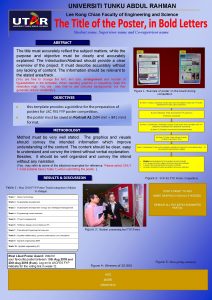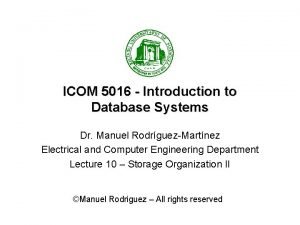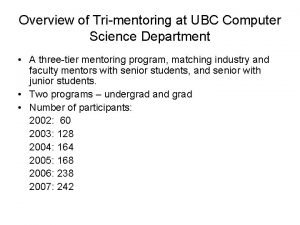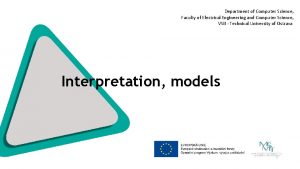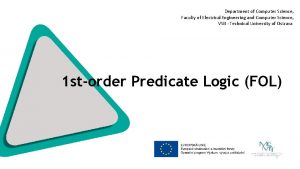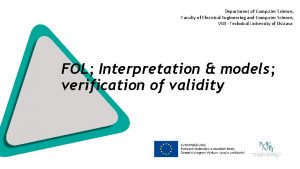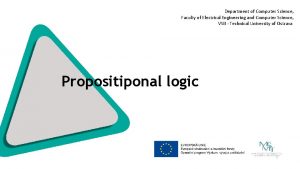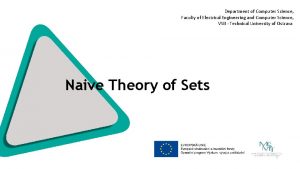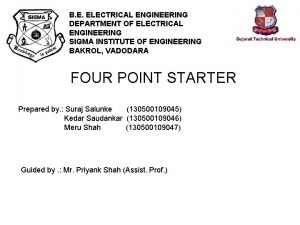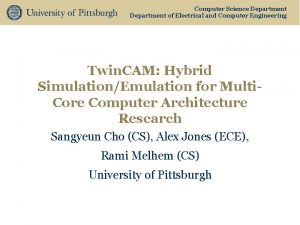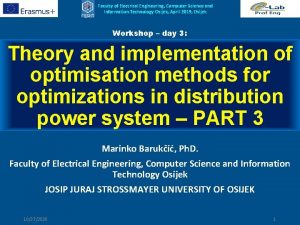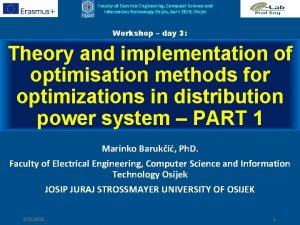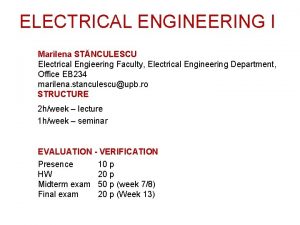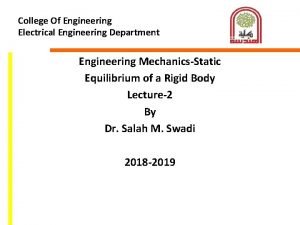Department of Computer Science Faculty of Electrical Engineering


![Normal forms of formulas (p q) [(p q) (q p)] ∀ [( p q) Normal forms of formulas (p q) [(p q) (q p)] ∀ [( p q)](https://slidetodoc.com/presentation_image/4cb4ba7713ddde610572f335a72ac485/image-3.jpg)



















- Slides: 22

Department of Computer Science, Faculty of Electrical Engineering and Computer Science, VSB - Technical University of Ostrava Propositiponal logic 1

α Normal forms of formulas of propositional logic ∃ ∀ • To each formula of propositional logic there is just one truth-value function, i. e. , mapping {p, q, r…} {0, 1} (the truth-value table). • On the other hand, to each such function there are infinitely many formulas, which are mutually equivalent. • Definition: Formulas A, B are equivalent, notation A B, if A, B have exactly the same models, i. e. , A and B express the same truth-value function. In other A entails B, and vice versa: |- words, A B iff A |= B a B |= A. • Example: p q (p q) (p p) . . . • Note: Do not confuse the equivalence of formulas A B (‘ ‘ is a sign of metalanguage!) with a formula of the form A B. However, it holds that A B if and only if the formula |= A B (is a tautology). • Example: (p q) [(p q) (q p)] iff • |= [(p q) (q p))] λ β 2
![Normal forms of formulas p q p q q p p q Normal forms of formulas (p q) [(p q) (q p)] ∀ [( p q)](https://slidetodoc.com/presentation_image/4cb4ba7713ddde610572f335a72ac485/image-3.jpg)
Normal forms of formulas (p q) [(p q) (q p)] ∀ [( p q) ( q p)] [(p q) ( p q)] …. • It is useful to determine a normal (standardized) form of a formula: to select one (or two) determined forms out of these infinitely many equivalent forms. β • The class of equivalent formulas is then represented by the chosen formula in the normal form. • In the above example the second and third formulas are in a normal form. ∃ • |- α λ 3

β Normal forms (of PL formulas): definition α Literal is a proposition symbol or its negation: ∃Elementary conjunction (EC) is a conjunction of literals. ∀ Ex. : p, q, r, . . . Ex. : p q, r r, . . . Elementary disjunction (ED) is a disjunction of literals. Complete elementary conjunction (CEC) of a given set S of elementary propositional symbols is an elementary conjunction in which each symbol (element of S) occurs just once: Ex. : p q Complete elementary disjunction (CED) of a given set S of elementary propositional symbols is an elementary disjunction in which each symbol (element of S) occurs just once: Ex. : p q Disjunctive normal form (DNF) of a formula F is a formula F’ such that F’ is equivalent to F and F’ has the form of a disjunction of elementary conjunctions. Example: |- DNF(p p): (p p) ( p p), p p Conjunctive normal form (CNF) of a formula F is a formula F’ such that F’ is equivalent to F and F’ has the form of a conjunction of elementary disjunctions. CNF(p p): ( p p) Complete disjunctive normal form (CDNF) of a formula F is a formula F’ equivalent to F such that F’ has the form of a disjunction of complete elementary conjunctions. UDNF(p q): (p q) ( p q) Complete conjunctive normal form (CCNF) of a formula F is a formula F’ equivalent to F such that F’ has the form of a conjunction of complete elementary disjunctions. UKNF(p q): ( p q) ( q p) CDNF and CCNF are called canonic (or standard) forms of a formula. 4 λ

∃ Normal forms of PL formulas ∀ How to find canonic forms (i. e. , CDNF, CCNF) of a formula? CDNF: disjunction = 1, if at least one CEC = 1, i. e. , all the literals in this CEC = 1. CCNF: conjunction = 0, if at least one CED = 0, i. e. , all the literals in this CED = 0. Therefore: CDNF (CCNF) can be constructed from the truth -table in such a way, that we take into account only rows |- with the value 1 (0) and ensure “the correct value of literals” – 1 (0). λ β α 5

∀ CDNF, CCNF - the truth-table method α Find the CDNF, CCNF of the formula: (p q) |- CDNF: p q β CCNF: ( p q) (p q) ∃ p q (p q) UEK UED p q 1 1 0 1 0 p q 0 0 0 p q λ 6

∃ CDNF, CCNF - by equivalent transforming method: p q (p q) CCNF [p (q q ] [ q (p p ] p q CDNF β Note: In the second line we make use of the fact that a |- disjunction of any formula A with a contradiction F is equivalent to A: A F A In the third line we make use of distributive laws Statement: Each formula which is not a contradiction has a CDNF, and α each formula which is not a tautology has a CCNF λ ∀ 7

Reverse task: given a CDNF, CCNF, find a simpler original formula ∀ Example • An alchemist is imprisoned. He received 5 messages with the following content: • p: You will succeed in converting lead to gold. • q: On April 1 st your brother-in-law will become an attorney. • r: After April 1 st you may expect pleading. |- 1 st message says: p q r 2 nd message says: p q r 3 rd message says: p q r 4 th message says: p q r 5 th message: At least one of the previous messages is true. β ∃ • Question: What did the poor alchemist learn? • Solution: (p q r) ( p q r). Hence we need to find a formula F which has the above CDNF. By means of distribute laws we obtain: (p q r) (p q) (r r) (p q) (p q) λ • Answer: You will succeed in converting lead to gold if and only if on April 1 st your brother-inlaw becomes an attorney. α 8

α ∃ Question: how many binary truth-value functions (hence how many binary connectives) are there? ∀ X Y 0 1 2 3 4 5 6 7 8 9 1 1 1 0 1 2 3 4 5 1 1 0 1 0 1 |- 1 0 0 0 1 1 0 1 0 0 0 0 1 1 1 1 0 0 0 0 0 1 1 1 1 β λ

Which is the minimal number of truth-functional connectives? ∃ |- α According to the Statement on normal forms (see slide 7) the following connectives suffice: , , (funkcionally complete system) The following systems of truth-functional connectives are functionally complete: 1. { , , }, β 2. { , } or { , }, 3. { , }, 4. { } or { }. Hence in order to express any truth-value function (and thus any PL formula) just one connective suffices! Either Scheffer’s NAND or Pierce’s NOR • ∀ λ 10

∃ Proof on the minimum of connectives • • |- The system { , , } is sufficient according to the Statement on normal forms Transition to the system { , } or { , }: A B ( A B), β A B ( A B) Transition to the system { , }: A B, A B (A B) λ Transition to the system { } or { }: A A A, A B (A B), ( is NAND), A A A, A B (A B), ( is NOR). ∀ α 11

Complete normal forms α ∃ |- ∀ Looking at a tableau, you can easily see why • a tautology does not have a complete conjunctive normal form (CCNF) and why • a contradiction does not have a complete disjunctive normal form (CDNF): β If a formula is a tautoloy, then all the branches of a conjunctive tableau are closed, i. e. , in each ED there is a couple of opposite literals p, which means p p. but then the elementary disjunction is not complete. Hence the CCNF of the formula does not exist. • Similarly for CDNF. λ 12

CDNF of tautology with one (T 1), two (T 2), three (T 3) variables ∀ |- ∃ T 1 p p T 2 (p q) ( p q) T 3 (p q r) ( p q r) β α For each valuation v there has to be at least one CEC true. λ 13

α ∀ ∃ If a formula is not a tautology, at least one of these CECs has to be missing in the respective CDNF. Therefore, if we construe a CDNF from a truth table, we take into account only those rows, where the function has the value 1 (value False – 0 does not |matter, because A F A) and construe CEC in such a way that the CEC is true. Similarly for CCNF – take into account 0 -s. β λ 14

β ∃ Resolution method in the propositional logic • From a practical point of view a semantic tableau is not favourable α • If you want to prove that P 1, . . . , Pn |= Z, it is equivalent to proving tautology |= (P 1 . . . Pn) Z, i. e. , P 1 . . . Pn Z is a contradiction. • But, to prove it by the tableau method, you need the disjunctive normal form. Which means that you have to transform the formula that is (almost) in the conjunctive form into the disjunctive form, |- which yields a lot of applications of the distributive law. • Using a tableau often yields a lot distributive steps • It is easier to directly prove the contradiction, i. e. , that the formula P 1 . . . Pn Z is not satisfiable. λ ∀

α ∃ ∀ Resolution rule in the propositional logic |- Let l be a literal. From (A l) (B l) infer (A B). Notation: (A l) (B l) –––––––– (A B) resolvent This rule does not lead to an equivalent formula. But it preserves satisfiability. Proof: Let formula (A l) (B l) be non-contradictory. hence there is a valuation v in which it is true. But then in this v both the disjuncts (so called clauses) are true: (A l) and (B l). Let v(l) = 0. Then w(A) = 1 and w(A B) = 1. Let v(l) = 1. Then w( l) = 0 and w(B) = 1, a thus w(A B) = 1. In both cases the formula A B is true in the model v of the opriginal formula, hence it is not a contradiction. β λ 16

Proof by resolution in PL |- If you realise that the above proof is valid for any valuation v, then you see that the rule is truth preserving: β (A l) (B l) |= (A B). λ • Thus you obtained also a method of finding logical consequences of a formula. • Moreover: ∃ (A l) (B l) (A B) ∀ α 17

Clausular form α ∃ ∀ • The conjunctive normal form is called clausal form. Particular conjuncts (i. e. , elementary disjunctions) are called clauses. • Example: Transition of a formula into the clausal form: [((p q) (r q) r) p] ((p q) (r q) r) p ( p q) (r q) r p • The formula consists of four clauses. |- The proof of contradiction: • ( p q) (r q) ( p r) r p p β λ 18

Proof by resolution ∀ α • R(F) – conjunctive extension of a formula F by all its resolvents ∃ • R 0(F) = F, Ri(F) = R(Ri-1(F)) – rezolution closure of F. It holds that Ri(F) F • Proof: A is a contradiction (not satisfiable): there is an n such that Rn(A) contains the empty clause: • Proof: A is a tautology: A is a contradiction β • Proof: a set of formulas {A 1, …, An} is not satisfiable. We prove that the formula A 1 . . . An is a contradiction • Infer logical consequences of {A 1, …, An}: infer all the resolvents • Proof of validity: A 1, …, An |= Z λ • Direct: by step-by-step inferring resolvents from A 1, …, An you obtain Z • Indirect: prove that A 1 . . . An Z is a tautology, i. e. , A 1 . . . An Z is a contradiction, i. e. , the set {A 1, . . . , An, , Z} is not satisfiable |- 19

Examples • • λ Particular clauses are numbered. gradually infer resolvents (that logically follow from the clauses). When performing an indirect proof, you have to infer p p, the empty clause α Prove that the following formula is a contradiction: ∀ ( q p) (p r) (q r) p 1. q p 2. p r 3. q r 4. p 5. p r rezolution: 1, 3 6. p rezolution: 2, 5 | 7. 4, 6 ∃ Question: What follows from the formula ( q p) (p r) (q r) ? Answer: the formula p β 20

Examples • ∃ 1. 2. 3. 4. 5. 6. λ Direct proof: p q r, s q, t r |= p (s t) p q r s q t r α p s r rezolution 1, 2 p s t rezolution 3, 4 p s t p (s t) QED ∀ β |21

Examples ∀ • Indirect proof: p q r, s q, t r |= p (s t) 1. p q r 2. s q 3. t r 4. p s r rezolution 1, 2 5. p s t rezolution 3, 4 α 6. p nega∃ 7. s ted 8. t conclusion 9. p s t, p, s, t |= s t, s, t |= t, t |= λ β |- 22
 Tum
Tum Usf electrical engineering faculty
Usf electrical engineering faculty Faculty of electrical engineering
Faculty of electrical engineering Clemson electrical engineering
Clemson electrical engineering Studis fe
Studis fe Lee kong chian faculty of engineering and science
Lee kong chian faculty of engineering and science Lee kong chian faculty of engineering and science
Lee kong chian faculty of engineering and science Electrical engineering department
Electrical engineering department Ucla electrical engineering
Ucla electrical engineering Bridgeport engineering department
Bridgeport engineering department Bridgeport university computer science
Bridgeport university computer science Fsu cs faculty
Fsu cs faculty Mathematical computation ucl
Mathematical computation ucl Brown university computer science faculty
Brown university computer science faculty Klipsch school of electrical and computer engineering
Klipsch school of electrical and computer engineering Mse iitd
Mse iitd Computer engineering department
Computer engineering department Northwestern electrical engineering
Northwestern electrical engineering Computer science department rutgers
Computer science department rutgers Meredith hutchin
Meredith hutchin Trimentoring
Trimentoring Bhargavi goswami
Bhargavi goswami Columbia university department of computer science
Columbia university department of computer science






